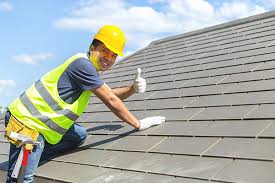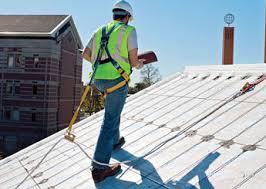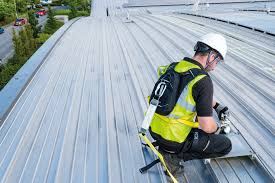What is roof safety?
What is Roof Safety?
Roof safety is a system of preventive measures when performing work and repairs on rooftops because it is one of the most dangerous jobs in the construction industry. Falls are the leading cause of death in the construction industry, and the Occupational Safety and Health Administration (OSHA) cites that falls from roofs account for 34% of all fall deaths.
5 Common Rooftop Safety Hazards
To protect roofers from serious injury and death it is important to identify hazards when working on rooftops and to follow critical safety steps to control these hazards. Below are the most common rooftop hazards that should be identified and controlled to keep roofers safe:
Fall Hazards
Always watch out for fall hazards when working at heights. Basic questions to ask yourself and your team should be: Is the structure strong enough to support the weight? Are there holes to watch out for? Are guardrails available for workers? Are ladders properly placed and not defective? Use an inspection checklist to ask the right questions and assess fall hazards when working from heights.
Power Tools
Power tools are essential when working on rooftops. However, if improperly used at heights, power tools can inflict serious damage to workers as well as cause slips and falls. Ensure your team is properly trained to handle power tools and that they are not defective.
Electricity
The construction industry is most at risk from electrical hazards, accounting for 52% of all electrical fatalities in the US workplace. Workers most at risk of electrical hazards include those working on rooftops and near power lines. Improper handling of electrical equipment can cause massive electrical shock, burns, fires and death. Conduct regular electrical safety checks to identify and control possible causes of electrocution to prevent accidents.
Hazardous substances
Common hazardous substances when working on rooftops include exposure to asbestos, paint fumes and harmful chemicals. Check for substances that may harm workers on-site and take appropriate action including proper storage and safe handling of hazardous substances.
Extreme temperatures
Whether it’s the heat of torches used for roofing or extremes in weather, workers must be protected from the dangers of extreme temperature by identifying the risks brought by equipment or current weather conditions. Have your team perform a toolbox talk before your shift to decide whether you should commence work for the day.

Roof Smarts
When it comes to roofs, even the best safety equipment is no substitute for common sense and good judgment. Here are some tips for working safely on a roof:
- Leave steep and/or high roof work to the pros. The few dollars you’ll save by doing it yourself aren’t worth the risk of death or a lifelong disability if you fall.
- Pick a clear, calm, cool time of day to work on roofs. Wet roofs are slippery. Wind also poses a danger, and excessive heat softens the shingles, making them vulnerable to damage.
- Wear shoes with a soft rubber sole for extra traction.
- Keep the bottom of your shoes free of mud and dirt, and the roof swept clear of dirt and debris.
- Rope or mark off the ground beneath your work area to let people below know you’re working above. Even the most careful worker eventually drops a tool off the roof. Always look and call out before tossing anything down.
- When you’re not using your power tools, secure them with short lengths of rope or Bungee cords. Keep hand tools and supplies in a 5-gallon bucket hung on a roof bracket. Carefully position ropes and extension cords so they’re not underfoot; they’re very slippery.
- Stay off slate and tile roofs. Loose tiles or slate can fall out and the surfaces are easily damaged if you’re not experienced.

Common Rooftop Safety Hazards
Every time you or your team access a rooftop you should take every precaution and avoid hazards and dangerous situations. But sometimes we all need a reminder about what specifically to lookout for, so we’ve compiled this list of the top 10 hazards you should be aware of before you access a rooftop.
- Roof Stability – Is the roof strong enough to support the weight of a human? Are the trusses intact? Will the roof bow on a hot day? Check the underlayment before going onto the roof.
- Ladder Security & Placement – Is the ladder secure and at a 4:1 angle? Are the feet secure? Is the top above the roofline and tied securely A number of fatalities occur each year because of a poorly placed ladder. Always inspect your ladder and the area around your ladder prior to use.
- Weather Conditions – Ice, snow, and wind are always a hazard on a roof if the shingles or other surfaces are slippery. Membrane roofs are especially slippery in wet conditions and should be avoided under these circumstances.
- Roof Holes – Unguarded skylights and poorly covered holes. Without fall protection, an open hole on a roof can be just as deadly as the roof edge, and according to OSHA 1910.23(a)(4) requires a skylight screen or railing on all exposed sides.
- Edge Awareness – Losing the edge of the roof can be a problem when you are engaged in roof work. Some employees get so wrapped up in their project that they forget where the roof edge is.
- Improper Training – If there is someone on the roof who has not been properly trained, they are a rooftop safety hazard and could cause serious injury to themselves or others.
- Improper Use of Fall Protection Equipment – Such as: poorly anchored railing, lanyard too long, or a weak tie-off point. Understanding and training on how to properly use fall protection equipment is critical.
- Poor Line of Sight – Ridge vents, chimneys, shingle bundles may block egress on a roof. Maintain a good line of sight so that you know where you are in relation to the roof’s edge.
- Pitch – The steeper the roof is, the easier the fall. Ensure that the fall protection and shingle bundles are secure before setting foot on the roof.
- Split Level Roofs & Fall Heights – Employees engaged in roofing activities on low-slope and split-level roofs with unprotected sides and edges 6 feet (1.8 meters) or more above lower levels should have the proper fall protection equipment.

Roof Safety Signs: What They Mean and What to Do
Safety signs are generally categorized in three types—danger signs, warning signs, and caution signs. When working on rooftops, roofers will usually encounter the following examples of roof safety signs and what they should do:
Danger Sign
When there is a roof safety danger sign, there are immediate hazardous conditions that will lead to serious injury and death if not avoided. Upon seeing this sign before any roofing work, avoid it at all costs.
Warning Sign
When there is a roof safety warning sign, there are existing life-threatening hazards that can lead to serious injury or death. Accessing roofs by permit means that only authorized personnel or trained employees can be on it. Warning signs represent a hazard level between danger and caution, needing specific precautionary measures to be taken.
Caution Sign
When there is a roof safety caution sign, there are minor hazard situations where a non-immediate or potential hazard or unsafe practice presents a lesser threat of employee injury. Roofers should be mindful of caution signs and apply necessary control measures in any roofing work.
Top 5 Safety Precautions for Roofers
- Always begin with your Pre-Start Talk
Make sure you always conduct a 5-10 minute pre-start talk with all workers before commencing work on a rooftop. Discuss common hazards present (like the common hazards above), assess the condition of the work area, confirm that proper permits have been secured, and encourage the team to verbalize the safety tips to follow. Using a pre-start toolbox talk template can help your team communicate and record their daily safety conversations.
- Work only during good weather conditions and avoid extreme heat/cold
Not only does extreme weather cause slips and falls, it can also hinder proper execution of roofing work (roof shingles not sealing down). A wet roof is also a huge risk for slips and falls. Better side with caution and always wait for ideal weather before you begin roofing work.
- Ladders should be stable and properly secured or tied off
Always make sure that there are enough ladders for the job and that they’re all safe to use. Check your ladders for safety as some of them may need repair or replacement to prevent fatal accidents or injuries.
- Wear proper PPE
Wearing proper PPE such as helmets, shoes with traction, and fall protection harnesses can help save you when slips and falls occur. Perform regular PPE checks to ensure your team is properly equipped.
- Carefully position ropes and extension cords so they’re not underfoot
When not properly handled, ropes and cords not only hinder workers’ movements, they can also cause fatal accidents. Always follow proper use of ropes, cords, and safety harnesses.